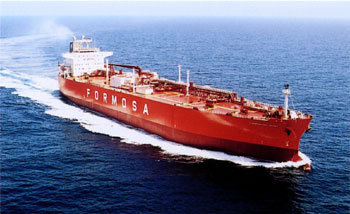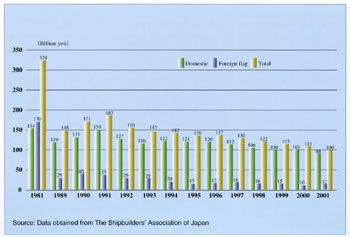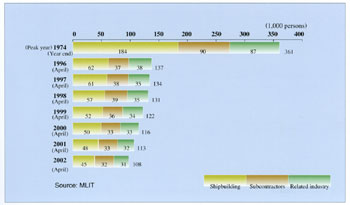|
Japanese Shipbuilding Industry
Current Status
New orders
The world total of newly placed shipbuilding orders in 2001 decreased, reflecting the feared slowdown of the U.S. economy and the impact of the terrorist attacks on September 11. It stood at 36,499,000 GT, down 20.8% on the year before according to the "World Shipbuilding Statistics" published by Lloyd's Register. Of this total, Japan accounted for 14,551,000 GT, up 8.0% over 2000 (representing a share of 39.9%) and regaining the top share for the first time in two years, Western Europe (AWES member countries), for 3,684,000 GT, down 44.1% (10.1%), and the ROK, for 11,840,000 GT, down 12.1% (32.4%).
According to the statistics on construction permits issued by the Japanese government, which cover ships of more than 2,500 GT (excluding passenger ships), 357 ships totaling 13,897,000 GT were ordered from Japanese shipyards in 2001, up 7.9% in terms of the number of ships or 19.9% in gross tonnage over the preceding year.
Breaking down the total newly ordered tonnage according to the ship type, dry cargo ships accounted for 7,416,000 GT (against 8,694,000 GT in 2000), tankers, 6,422,000 GT (against 2,873,000 GT), and others, 58,000 GT (against 25,000 GT).
To further analyze the dry cargo carrying tonnage, bulk carriers decreased 37.8% on a GT basis, and their share in the total newly ordered tonnage also shrank to 30.7% (against 59.1% in the year before).
| (拡大画面:108KB) |

|
| Fig.1 Japan's newbuilding |
Orders for crude oil tankers totaled 4,328,000 GT, up by a massive 164.5% in GT over 2000, and their share in the total newly ordered tonnage also expanded to 31.1% (against 14.1% in 2000). They included 12 VLCCs of 1,902,000 GT (against eight vessels of 1,270,000 GT).
The past year saw orders for more LPG carriers and LNG carriers than in 2000, respectively totaling 23 of 386,000 GT (against 17 of 284,000 GT) and seven of 653,000 GT (against five of 516,000 GT). Orders for chemical carriers and product tankers also increased respectively to 37 of 369,000 GT (against 16 of 176,000 GT in 2000) and 23 of 687,000 GT (against eight of 260,000 GT).
To break down the overall newly ordered tonnage into domestic and export vessels, while the former totaled 379,000 GT (representing a share of 2.7% in the overall order intake, up 247.7% over the year before), the latter stood at 13,517,000 GT (a share of 97.3% and up 17.7%).
For additional reference, newbuilding orders worldwide in the January-June half of 2002 added up to 8,520,000 GT according to "World Shipbuilding Statistics" published by Lloyd's Register, in which the share of Japan was 3,441,000 GT (or 40.4%), that of Western Europe (AWES member countries), 530,000 GT (or 6.2%), and that of the ROK, 3,354,000 GT (or 39.4%).
 |
| 298,399DWT double-hull VLCC, Nippon, completed by Hitachi
Zosen Corp. (present Universal Shipbuiding Corp.) |
Shipbuilding Activities
In 2001, keels were laid for 343 vessels of 12,155,000 GT (up 22.4% over the preceding year), 345 vessels of 12,378,000 GT were launched (up 6.8%), and 343 vessels of 12,002,000 GT were completed (up 0.6%). This represents an expansion in the number of keels laid, launches and completed tonnage over the preceding year.
Order backlog
The newbuilding order backlog at Japanese shipyards at the end of June 2002 stood at 391 vessels of 17,355,000 GT, up 4.1% over the end of June 2001. The total comprised 25 domestic ships of 663,000 GT and 366 export ships of 16,692,000 GT.
Repairs and Conversions
Repair and conversion work in fiscal 2001 earned the industry \100 billion, down 9.9% from the previous year. The amount of repair and conversion work for fiscal 200 1 was the lowest since fiscal 1981. This is due to the fact that the number of domestic and export ships had gradually declined.
 |
18,255GT car/passenger ferry, Lilac, completed by Ishikawajima-Harima
Heavy Industries Co., Ltd. (present IHI Marine United Inc.)
|
 |
| 54,800DWT LPG carrier, Formosagas Bright, completed by Kawasaki
Heavy Industries, Ltd. (present Kawasaki Shipbuilding Corp.) |
Labor Situation
The number of workers engaged in shipbuilding (including those employed by subcontractors) and ship machinery manufacturing was 108,000 in April 2002. The average age of workers at present is over 40 years.
Improved working environment and employment conditions are necessary for facilitating recruitment of young employees, and the industry must also provide training systems to attract a competent staff.
In Japan shipbuilding facilities are increasingly taking advantage of computer-aided engineering methods such as CAD/CAM in a drive to increase productivity by modernizing and automating the industry and in order to cope with the decreasing and aging population of skilled workers.
The final goal of such modernization is to incorporate CIM (Computer Integrated Manufacturing) using the latest information processing techniques including CALS (Continuous Acquisition and Life-cycle Support) into shipbuilding. Individual shipyards have been conducting R&D on shipbuilding CIM since 1992.
| (拡大画面:102KB) |

|
| Fig.2 Shiprepair sales |
Business situation
The combined sales of the 18 member companies of the Shipbuilders' Association of Japan were \6,602 billion in fiscal 2001, representing a 4% decrease from the preceding year.
Categorizing total sales by business sector, the shipbuilding business (comprising newbuilding, ship repair and conversion) earned \1,344 billion (up 2.6% over the preceding year), and all other sectors (heavy machinery, industrial plants, etc.) earned \5,258 billion (down 5.8%).
The share of the shipbuilding sector in total sales was 20% in fiscal 2001. The contribution of the shipbuilding business to the overall sales of the companies averaged 13% for the seven majors and 93% for the 11 medium-size shipbuilders. This indicates a very high proportion of non-marine business in the seven major companies, whereas the 11 medium-size companies are more specialized shipbuilders, relying heavily on the marine business.
 |
300,000DWT double-hull VLCC, Kaimon II, constructed by Mitsui
Engineering & Shipbuilding Co., Ltd.
|
| (拡大画面:70KB) |

|
|
| Fig.3 Shipbuilding industry labor force |
|